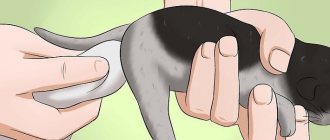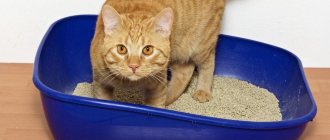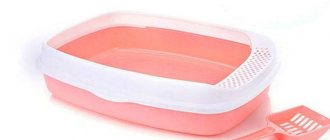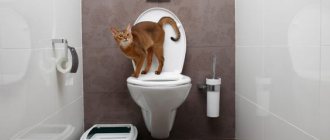With the arrival of a cat in the house, you need to organize all the living conditions for its comfortable existence: determine a place to sleep, select dishes for feeding and, of course, arrange a toilet where it can relieve its natural needs.
Manufacturers produce special trays for domestic cats - convenient toilet accessories that can be easily cleaned from animal feces. You can add special fillers to the tray to neutralize the odor. When all the necessary accessories are prepared, the most important thing remains - to teach your pet to go to the toilet in a litter tray.
In this article we will look at how to train a cat to use a litter box, features of replacing litter in the litter box, and caring for the cat litter box.
How to arrange a cat litter box
If the animal finds it uncomfortable to go to the potty, he will soon choose another, more comfortable place. Therefore, it is important to choose the tray and litter according to your cat's preferences, and then install it in an appropriate location.
Selecting a location
Cats by nature love to hide. Some individuals are embarrassed to go to the toilet in an open space and in front of people. To make your pet as comfortable as possible, you need to place the tray in a quiet place with open access.
Many owners prefer to install the cat litter box in the restroom and leave the door ajar. Another option is a special slot in the door for easy access for the mustachioed. For many families, this is the only acceptable option: unpleasant odors will not spread throughout the house, and the cat will be able to go to the bathroom alone.
If it is not possible to place a tray in the bathroom, you can consider the option of a closed tray-house: it can be placed anywhere in the apartment. The cat will be hidden from prying eyes, and unpleasant aromas will not leak through the thick walls. The only negative is that a kitten is unlikely to like such a house; this is an option for an adult pet.
It is advisable to limit the pet’s movement area to any one room in which the tray is located while the skill is being developed. Then he will quickly learn the place of origin of his needs.
Buying a litter box and cleaning it
It is better to choose a tray from non-electrifying plastic with fairly high sides, about ten centimeters (for a kitten - lower, up to five centimeters). It should be roomy enough so that the pet can comfortably fit in it and be able to cross its paws. If the cat is not from the street, but simply changed its owner, ask the previous owner what kind of litter box the pet used - this will help accustom it faster.
Cats like closed structures in the form of houses more, as they create a feeling of seclusion, but caring for such toilets is much more difficult than a regular litter box. An additional advantage of closed toilets is the presence of special filters that absorb unpleasant odors.
Perhaps the most popular option for cat litter is a plastic tray with a removable grid. But it is not suitable for all pets. Some cats outright refuse to use a tray with stale litter: they are afraid of getting their paws wet.
Therefore, the tray must be cleaned regularly: it is necessary to change the filler and wash the tray with a disinfectant. Be careful not to use chemicals that are too odorous - they may scare the animal away and force you to avoid the potty.
Some cats absolutely need sterile cleanliness: they meow loudly and follow the owner so that he cleans up their feces immediately and immediately. Others are less scrupulous and may use the used tray several times.
Purchasing filler
It is much easier for an outdoor cat to get used to a tray with a filler that resembles sand or sawdust (mineral, wood). At first, you can use sand from the street, into which portions of filler are gradually mixed.
If your pet is accustomed to a particular litter, you should not suddenly change it to another, since you will have to accustom an adult cat to the litter box all over again - he will simply boycott the unfamiliar potty. You need to gradually mix portions of the new mixture into the old one until you completely replace it and the animal gets used to it.
For kittens it is better to use natural (wood, soy, coal) fillers. This is due to the fact that the baby may try the granules on the tooth out of curiosity. Later it will be possible to transfer it to a mineral or silica gel filler.
Choosing a location for the tray
The success of finding an answer to the question of how to quickly accustom a kitten to a litter box largely depends on the right location. If we focus on the psychology of cat behavior, then this should be a secluded and quiet place, which will be perceived by the pet as as safe as possible.
A bathroom or toilet fits this category quite well, but another unpleasant moment arises - the door to the room must be open, and this is not always convenient. You can solve the problem with the help of a special “cat door”, which is installed at the bottom of the door. Essentially, this is a passage for the cat through which he can get to the toilet. Another great solution is to install an accordion door, which allows you to open the room just enough for the cat to move freely, while the main part of the room remains hidden from prying eyes.
5 rules for choosing a place:
- The place that you chose and began to accustom the kitten to should be permanent. Otherwise, the tail will be stressed due to the disappearance of its favorite potty. In addition, cats are big conservatives and will persistently continue to go to the toilet in the place where the tray used to be.
- The litter box should not be located near the cat’s “dining area.” Firstly, remember the rules of hygiene, and secondly, having placed the tray in this way, you will have to make a lot of effort to accustom your pet to it.
- If you have several cats in your family, make sure that the location of the litter box does not become a play area. Fluffy bullies often like to unexpectedly jump out of ambush, the role of which is given to the toilet.
- Position the toilet so that cats do not have to climb steps; such actions are especially difficult for kittens. For multi-storey buildings, it is optimal to install a tray on each floor.
- The tray can always be camouflaged and built in, although this will require the participation of furniture production specialists.
How to train a kitten to use a litter box
A small pet is just beginning to explore the world and learn new things, so it will not be at all difficult to develop the skill of going to the toilet; training an adult cat to use the litter box is usually more problematic. Under no circumstances should you show aggression or anger if things don’t work out as quickly as you would like.
The optimal age for an animal to begin training is 2-6 weeks. The main guarantees of success: the correct choice of tray, its installation location and filler. A kitten should not buy a tray with very high sides “for growth”, otherwise he will refuse to use it due to inconvenience. For the same reason, it is better not to install a toilet-house as the first tray.
A kitten goes to the toilet more often than an adult animal. If you notice that the baby is restless, scratching his paw on the floor, walls or furniture, or spinning in one place, immediately carry him and put him in the tray. Do not create a fuss while doing this; the pet may get scared. You can help the cat and, taking his paws in your hands, scratch the litter.
Wait until the baby does his business, and then praise him. You should not give him a treat: encouragement with your voice and stroking will suffice.
Sometimes it is enough to carry out such manipulations several times, and the animal understands what they want from it. It happens that it takes much more time, please be patient.
If the kitten misses, there is no need to scold him or scream: he will be scared and is unlikely to understand what happened. Point him to the puddle, and then take the baby to the tray.
Some owners are lucky and do not face the problem of toilet training their animal. If the kitten they adopted grew up with a cat mom, chances are she taught him everything.
How to get rid of unpleasant odor
In the process of training a kitten to use the litter box, it is distressing when the baby passes by. But the smell of urine from a prepubescent kitten is not very irritating to the sense of smell and can be easily cleaned out. But if an adult cat confuses the tray with a sofa, carpet or the owner’s clothes and commits an obscene act, then it will be very difficult to completely get rid of the strong odor.
Here are some tips suggested by our readers:
- The easiest way is to blot the wet spot on the upholstery of the sofa, carpet, bed with an old cloth or paper towel, toilet paper or newspaper. At the same time, make only pressing movements and under no circumstances rub. This will increase the area emitting the smell significantly.
- A solution of vinegar and water in a ratio of one to two removes a specific odor well. It is necessary to apply this solution with a spray bottle several times to the stained area, each time allowing it to dry. The effect will be enhanced by using a washing vacuum cleaner for cleaning.
- Regular baking soda works well to remove urine odor. Sprinkle the washed area with baking soda, and apply a mixture of three percent hydrogen peroxide and dish detergent on top. Thoroughly distribute the soap solution over the baking soda powder, let dry and clean with a vacuum cleaner.
- They perform excellent disinfection, and therefore remove odor, potassium permanganate or iodine. To do this, prepare a weak solution of potassium permanganate or an iodine solution of ten drops per liter of water. But it is worth remembering that each of these products can stain the surface being treated. Therefore, before use, be sure to test in an inconspicuous area.
- You can use fresh lemon juice. The citrus scent will not only remove urine odor, but will also prevent relapse, since the cat does not like this smell.
- A universal remedy in the fight against the consequences of cat uncleanliness is laundry soap.
How to train an adult animal: algorithm of actions
Adult felines are very scrupulous and picky about the toilet. They are disturbed by noise and various external stimuli. To fulfill their natural needs, they instinctively choose hard-to-reach, secluded corners, for example, places behind a closet or behind a sofa, where it is quiet and there are no prying eyes. Therefore, while the animal adapts, it is better to play it safe and block off such areas.
There is no difference in learning ability between male and female cats, especially for sterilized pets.
When working with an animal, you should take into account that each pet has its own character and level of intelligence. Some people learn to use the litter box fairly quickly, while others need time to form the desired habit. Difficulties usually arise when training adult pets - especially if the cat came into the house from the street, where there were no rules for the discharge of natural needs.
To develop the necessary skill in your pet, you need to place the cat litter box correctly. It should always be available and located in a convenient location. A bathroom or a warm loggia are the most suitable options.
The animal must be explained what a tray is and for what purposes it is used. This must be done patiently and calmly, without getting irritated, much less without any physical influence. Cats are very smart creatures; they respond well to changes in voice intonation. Take advantage of this. Barbaric methods like poking your nose into a puddle will not speed up the learning process, but, on the contrary, will complicate the task, increase the duration of adaptation and turn your pet into a frightened creature.
A scheme for training an adult cat to use a tray to obtain the fastest results may look like this:
- The need to relieve oneself in animals usually occurs after eating. For the first time after a cat appears in the house, do not leave it unattended. When the animal has eaten, carefully take it to the tray. Sit near the cat, wait. When she relieves herself, praise and pet her. But don’t rush to clean the litter box – let your pet form an olfactory connection.
- The animal may want to go to the toilet not immediately after a meal, but at another time. Signs of this are as follows: the animal begins to worry, sniffs corners, and scratches the floor. In this case, you need to take the pet to the litter box, wait until everything is over, and praise it.
- If it happens that you didn’t notice and the cat did its “dark” business in the room, then do not rush to punish it. Blot the puddle with a napkin and take it to the tray. Let your pet smell it. If the cat came into the house from the street, sprinkle the puddle it made with sand and take the wet sand to the tray. Give your pet a chance to explore the litter box and form an olfactory connection. The place where the puddle was must be washed with perfume or strong-smelling substances: vinegar, alcohol, kerosene. You can drop and rub a couple of drops of essential oil with the aroma of citrus or lavender on the washed area.
- It happens that the pet himself chose a place for the toilet, and it does not coincide with where the tray is located. In this situation, there is only one way out - put the tray in the place that the cat chose. Once the habit is established, begin to gradually move the tray so that over time it ends up in the place you want. The movements need to be made small: 1-2 centimeters per day.
- Don't take risks and don't leave outdoor shoes in the access area. The smells of the street can provoke the animal, and it will be very difficult for you to rid your favorite shoes of cat odors.
- If another cat previously lived in the house, treat the area where her litter box was located with a strong-smelling compound. Cats' sense of smell is unique. A new resident may be able to smell the scent even if several years have passed and will be tempted to mark the area.
- In pet stores you can purchase a special spray for toilet training a cat, which is recommended for treating the litter box. There are also sprays with a repellent odor, which are recommended for treating risk areas, such as the hallway.
If the cat knows where the tray is, but periodically goes to another place, you need to take a good look and look for the reason. Perhaps something is bothering your pet.
Is it possible to teach a cat to go to the toilet?
Some cat owners do not want to install a litter box in their apartment; they prefer that the animal go to the toilet on the toilet. But you won’t be able to completely avoid using a cat potty, since you can accustom a cat to a litter box, including an outdoor one, only through an “intermediate object,” namely a litter box. An animal that is not familiar with the litter box will not be able to learn to relieve itself on the toilet.
If your pet clearly knows that her business needs to be done in the tray in a strictly designated place, you can move on to changing habits - going to the toilet to the toilet. Do everything gradually. If you rush, you'll have to start all over again. Move the tray every day by 1-2 cm, moving it towards the location of the toilet.
For the next stage of training, prepare a large stack of paper, newspapers or magazines. Place newspaper under the tray after each use. Do not put too much at once - no more than 1 cm at a time. Otherwise, the pet may begin to show character and go on strike, leaving puddles on the floor.
In the process of raising the structure, the amount of filler should decrease. The best option is ꟷ if you didn’t use it from the very beginning. Be careful about the stability of the stack of newspapers. If the structure collapses at the most crucial moment, the animal may become frightened, and all training will go down the drain.
When the tray is at the level of the toilet, secure the result and let your pet finally get used to it. After a few days, you can move the tray onto the toilet itself and remove the pile of paper. Make sure everything is installed securely. It is better if you raise the seat; without plastic elements, the design is more stable, and this is very important.
At the last stage, you need to remove the tray; it is better to take it out of the apartment altogether so that the animal cannot find it by smell. When the cat wants to go to the toilet, she will be forced to use the toilet. After all, the tray had been standing there for the last few days.
There are times when your pet refuses your proposed plan at this stage. There may be signs of protest on the floor. In this case, you should return the tray to the toilet and try again.
There is another option for completing training - longer, but more reliable. To implement it, cut the bottom in the tray, gradually increasing the diameter. When the hole is the same as in the toilet, you can simply throw away the sides from the tray. And the cat is guaranteed to do his business in the desired place.
Some owners resort to a special tray attachment for the toilet - it also does the job well. But the attachment is used at the last stages of training, so a regular tray will still be needed at first.
There are two important rules for toilet training an adult cat: the toilet lid should always be up and the door to the toilet should always be open.
Tray selection
If you are wondering how to train a kitten to use a tray, then you need to start with a suitable tray.
The simplest designs are a rectangular plastic tray with straight or slightly rounded low sides. There are no additional nets in this toilet. Most often they have a rectangular shape, less often there are triangular ones, which are installed in the corner.
The advantages include sufficient compactness, ease of care and washing, easy visual control of the condition of the toilet and low cost. Main disadvantages:
- not the most attractive appearance;
- mandatory need to use filler;
- particles of filler often end up on the floor when burying the “treasure” is very intensive.
If you decide to purchase such a tray, look for a model with silicone linings or add a rubber mat. This is especially true for those trays that will stand on tiles. The design will become more stable and safe for the pet.
Trays with a limiting grid, which is fixed above the base of the tray, have a slightly more complex design. When using such a toilet, the paws always remain clean and no filler is required. The only drawback is that the contents must be cleaned immediately, since there is no filler in the tray that would absorb odors. In addition, cats often try to bury the grate and cling to it with their claws.
When choosing such a tray, pay attention to the grid. It should be made of good plastic that will not bend much. How can I check this? Press down lightly on the grate, optimally so that when it bends, at least 2 cm remains to the bottom.
There is another type of open type - trays with removable sides; they can be equipped with a mesh or without it. This design is suitable for cats that often “miss” and like to actively bury what they have done. The only drawback is that they are quite bulky.
The tray-house has no restrictions on installation on the territory of the apartment, since it perfectly retains all unpleasant odors. It will be appreciated by those who do not want to leave the bathroom or toilet door constantly open. When purchasing such a toilet house, pay attention to the quality of fastening and the ease of detaching the upper part.
The biggest problem with such structures is that cats very often sleep in them, considering them the safest place in the house, so there is no question of using the litter box for its intended purpose. How to solve a problem? Before accustoming your kitten to the litter box, remove the top part for a while so that the pet understands the purpose of the place.
A serious device among pet supplies is the dry closet, which is a structure with removable carbon filters. The latter do an excellent job of removing unpleasant odors. On average, one such filter lasts for 5-7 months of operation, followed by replacement with new ones. The lion's share of the market belongs to Italian and Japanese manufacturers, which leads to the main disadvantage - the rather high cost.
The height of ingenuity in the issue of cat litter are mini toilets for tailed cats, which have a separate connection to the sewerage system, the electrical network and cold water supply. The complexity of the design seriously limits the list of places where it can be installed; most likely it will be a bathroom or toilet. During operation, you will need to replace cartridges and purchase a special washable filler. It may not be possible to quickly train a cat to use the toilet; they are often frightened by the processes that occur during cleaning.
Cleaning and care
If you are an experienced breeder and are no longer wondering how to train kittens to use a litter box, but at some point your pets have stopped using their litter box for its intended purpose, pay attention to how and with what you clean the litter box.
The frequency of cleaning will depend on the design; if the tray has a grid, washing is carried out as many times as the pet uses it. If you and your cat have made a choice in favor of the litter, then you can remove lumps using a special scoop and wash it twice a week.
Rinse the tray with warm water and soak with a mild detergent for 5-7 minutes. Go along the bottom with a brush or the rough side of a sponge. The corners of rectangular trays, which often remain untouched and accumulate an unpleasant odor and plaque, require special diligence.
Rinse the washed tray with warm water and wipe dry with a cloth. An excellent way to get rid of unpleasant odors is regular baking soda.
Training aids
Since all owners want to accustom their cat to the litter box quickly and forever, they often begin searching for aids. Special sprays can be good helpers. There are two types of pharmaceuticals:
- with an attractive effect;
- with a repellent effect.
The principle of operation of the first type of products is based on the fact that their smell attracts the cat, forcing it to go to the toilet in the right place. The secret of this effect is simple: it contains urea, in other words, urea. Therefore, some cat owners do not want to purchase an aerosol; they simply moisten a napkin with the animal’s urine and place it in the right place. But using a spray is much more convenient, and such preparations are inexpensive. The product should be sprayed around the tray: on a piece of paper left nearby, or on the filler itself.
Sprays with a repellent effect are used to treat potentially at-risk areas, such as shoes, places behind furniture, and rugs. It is also recommended to use them in areas where the animal has already left a puddle.
All specialized products are absolutely safe for cats. But there are people who prefer folk remedies, for example, lavender oil. Use a few drops in the place where the animal gets into the habit of going to the toilet - the aroma repels cats well.
Citrus fruits also seem unpleasant to cats - you can leave the peels of oranges or tangerines in the place where the animal has shitted several times.
Fillers
Not so long ago, traditional cat litters were torn newsprint, sand or soil brought from the street. This is not very hygienic and can even be dangerous for the animal. Today, it is convenient to lure a curious kitten into the litter tray with the help of litters sold in specialized stores. With them you can quickly accustom your baby to a permanent place. In a tray with attractive filling, he can row to his heart's content, examine it, sniff it thoroughly, and in general, have a good time.
There are chemical and natural fillers. The first ones are included in the expensive segment and are silica gel granules that can absorb not only moisture, but also unpleasant odors. However, despite the “high technology”, owners are often convinced that this is not the best option for kittens. Children often do not perceive silica gel as a toilet surface; they begin to roll out in it, as if on a bed, and taste the granules, which, however, is not dangerous.
Among the mineral fillers for kittens, it is better to choose wood, which is pellets made from sawdust from coniferous trees. They are inexpensive and completely safe for babies, unlike another natural filler in bentonite clay granules. An unintelligent kitten may accidentally swallow such a clay granule, which can lead to blockage of the digestive tract.
Some kittens are quite willing to go to the tray even without litter. Among them are mainly those who were taught good manners by their mother cat.
Reasons for possible difficulties
When developing the skill of defecating in the right place, difficulties sometimes arise. They can be caused by various reasons. Just watch your pet to understand why training is so difficult.
Sometimes it happens that an animal went to the toilet in the right place, and then suddenly stopped. In this case, you need to understand what causes this behavior and how to re-accustom an adult cat to the litter box.
Disease
The most dangerous and unpleasant reason for refusing to go to the toilet is illness. If something is bothering your pet, he may change his behavior in an attempt to let you know that something is hurting him.
In some cases, due to illness, he simply forgets where to go to the toilet, or this process causes him severe discomfort and pain. This may be urolithiasis, kidney failure or cystitis. If you notice changes in the animal's behavior, anxiety, lethargy, or other symptoms of the disease, you should contact your veterinarian. After the course of treatment, your pet will recover and, most likely, will return to its usual toilet.
Stress
Litter box refusal can also be caused by stress. It is worth considering that cats, like people, have different personalities and stress tolerance. Therefore, each requires a special approach. Limit the animal from stress as much as possible, be patient, do not punish the cat for mistakes - and very soon she will understand what you want from her.
It happens that changes in life circumstances cause anxiety in an animal. For example, a new person has appeared in the family or someone has died. In this case, try to devote as much time as possible to your pet. If you have a second cat, you should designate a litter tray for each pet.
New tray or new place
Cats are animals that do not tend to change their habits; they quickly become attached to their territory and certain places. Therefore, when changing the tray, a problem may arise such as refusal to go to the toilet in the usual place. What can we say about moving?
If you change the tray, sometimes you have to start training again - be prepared for this. If you are planning a move, make sure the new location has privacy areas for the cat and elevated areas for observation. The fewer reasons for stress the animal has, the better the adaptation will be and the fewer problems will arise with the toilet.
The period of sexual hunting
Sometimes difficulties are caused by the so-called mating season. It’s quite easy to check whether a cat leaves marks intentionally or whether there is another reason for his behavior. If the pet becomes more restless - it looks from the outside as if he is looking for something - and the animal urinates in small portions on a vertical surface, then we can definitely talk about the cat’s sexual activity. The solution is castration or regular mating with a cat.
Psychological reasons
There is an opinion that a cat can leave puddles out of spite, thus showing its stubbornness and discontent. Not all experts recognize this possibility - there are supporters of the theory that cats do not have consciousness, therefore, they do not know how to take revenge. In fact, many owners know that a cat can take a shit if it is offended - but almost immediately. Animals are definitely not capable of delaying revenge and serving it cold.
If your pet is loved and caressed, but he still walks in the wrong place, first of all you need to rule out the disease. If everything is fine in this regard, you need to decide how to most gently accustom an adult cat to the litter box again, taking into account the identified reason: often puddles or piles become an attraction for the owner’s attention. A couple of examples:
The cat feels sad when left alone for a long time. The owner returning late finds a fragrant “gift” in an unexpected place. Getting a second pet will solve the problem.
The cat likes or doesn’t like something. If he wants to go for a walk, but they don’t let him in, he can shit under the door. Or there is a desired item in the closet, which means the cat can go near the door of this closet.
More complex causes are difficult to identify. Sometimes monitoring an animal takes several weeks, or even months. But patient owners cope with the problem, no matter how ingenious it may be.
Why does the animal not go to the litter box and what to do in such a situation?
Occasionally it happens that a cat stubbornly refuses to go to his potty and keeps trying to settle down in the wrong place. Most often this is due to objective reasons:
- The animal doesn't like the potty. Perhaps it has become small and the cat is uncomfortable there. The filler is probably not suitable.
- The tray is in the wrong place. The pet may not be happy with the changes that have occurred after renovation, moving and/or rearranging furniture.
- Another tenant appeared. This could be a small child, a puppy or a second cat.
- The potty is poorly maintained and the cat does not like the strong smell.
- Sometimes pets become mischievous from a lack of attention from their owners. In this way the cat is trying to show his displeasure.
- During puberty, all cats begin to need to mark their territory.
- Violations of hygienic behavior can be associated with diseases of the digestive system, abnormalities in the genitourinary area, as well as helminthic infestations.
You need to carefully observe your pet and find out the reason why he stopped visiting his toilet. Only after this do they take any action to eliminate the interfering factor. If all else fails, then you need to take the animal to the veterinarian for tests and advice.
If nothing helps and the pet continues to shit everywhere, then you need to show it to the veterinarian
If the kitten regularly goes to the litter box for its needs, but at the same time marks the territory and sometimes shits in the corners, then it is recommended to reduce the pet’s sexual activity and nervousness with the help of special medications (Gestrenol, Kot Bayun, etc.). All marks must be thoroughly washed off and the smell must be eliminated with specialized sprays. But the most effective way to solve the problem is castration or sterilization.
Action must be taken immediately. The longer a cat shits in the corners, the more difficult it is to wean him from it.
What not to do
Under no circumstances should you punish your pet. If you start poking your animal’s nose into his feces, he will not understand that he is being scolded for going to the toilet in the wrong place; he will simply regard this as a punishment for a completed physiological act. In the future, the cat will hide from you in more secluded places in order to carry out its “dirty deeds”.
You should not forcefully hold your pet in the tray while waiting for him to go to the toilet. The animal will simply get scared and will avoid the tray.
The cat will definitely understand what they want from him - you just need to be affectionate towards your pet. It is not an easy task to accustom an outdoor cat to a litter box, and the result will depend on how you behave. The main key to success is patience; after a certain amount of time, the cat will definitely figure out what to do, and you will find happiness and peace.











